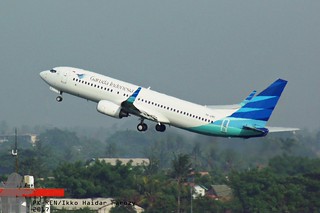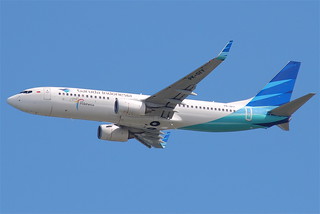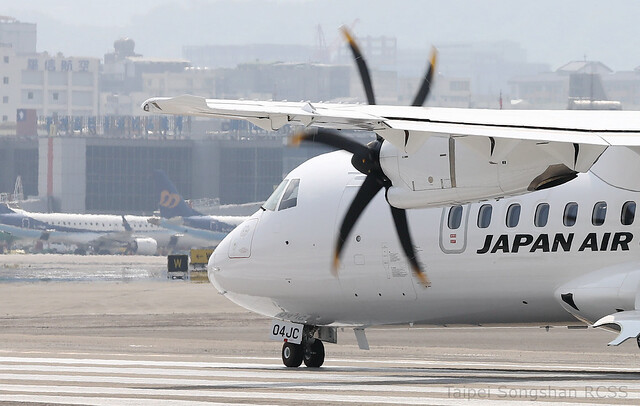Garuda AT72 at Ende on Oct 19th 2015, unstabilized approach leads to bounces, runway excursion and balked landing
Last Update: July 6, 2021 / 16:23:40 GMT/Zulu time
Incident Facts
Date of incident
Oct 19, 2015
Classification
Report
Airline
Garuda Indonesia
Flight number
GA-7017
Departure
Kupang, Indonesia
Destination
Ende, Indonesia
Aircraft Registration
PK-GAF
Aircraft Type
ATR ATR-72-200
ICAO Type Designator
AT72
On Jul 6th 2021 Indonesia's KNKT (aka NTSC) released their final report concluding the probable causes of the serious incident were:
- Continuation of an unstabilized approach with high approach speed, nose down attitude and with the roll about 3° to the left resulted in the aircraft bounced to the left of the runway centerline.
- The absence of immediate go around after the first bounce resulted in the aircraft made second touched down on the left shoulder of the runway.
The KNKT summarized the sequence of events:
At 0537 UTC, the SIC advised to the ACO that the aircraft was turning on final runway 27. The ACO responded that the wind direction was 150° with velocity of 18 knots and advised that the runway was clear. According to pilot observation, the weather was clear without scattered cumulus.
During turning on final, approximately 400 feet, the PF increased the rate of descend to adjust the approach path. The speed increased to around 140 knots and the PIC reduced the power.
On short final, the SIC checked the wind shock located on the right side of beginning runway and was coherent to the information of the wind condition from the ACO.
The aircraft touched down on the touchdown zone with nose wheel touched the runway first and bounced to the left of runway centerline and the aircraft experienced the second bounce on the left shoulder of the runway. During the second bounce, the master warning light illuminated triggered by “Pitch Disconnect” warning light.
The SIC noticed that the right control column was functioning and took over the aircraft control while PIC was trying to check the left control column function. The functioning control column on the right side changed the pilot roles, the SIC acted as PF and the PIC acted as PM.
After the second bounce, the Flight Data Recorder (FDR) recorded increasing value of TQs. The pilot made go around and turned to the right to avoid obstacle at the end of runway 27. After completed the go-around procedure, the PIC was aware of the severity of the occurrence then asked the ACO to check the possibility of debris leftover on the runway or left shoulder as result of aircraft bounced. The ACO then reported that there was no debris leftover on the ground.
After the pilots assessed the situation, they decided to divert to Labuan Bajo. During the flight, the pilot explained the situation to the flight attendant and also asked the passenger condition. There was no reported injury to the passenger nor the flight attendant. The flight continued and landed at Labuan Bajo.
The maintenance engineer at Labuan Bajo noticed grass and dirt at the right side of the aircraft, the crew explained they had some bounces at Ende however without mentioning a runway excursion. The engineer reconnected the elevators. The aircraft subsequently continued to Bali (Indonesia) and flew another sector with a different crew. In the meantime Indonesia's DGAC received a report from AirNav Indonesia, inquired with the safety department of Garuda, the safety department established a runway excursion had happened and grounded the aircraft.
The KNKT analysed:
Based on the FCOM, the final approach speed was Vref (VmHB), with maximum correction of 15 knots for gusts. For the estimated landing weight during the occurrence, the VmHB was 105 knots. Therefore, the maximum possible approach speed was 120 knots.
The FDR recorded that during the final approach, the aircraft speed was relatively high. After the aircraft passed the atoll and passed altitude of 358 feet, the pilot pitched down attitude while the engine power was maintained, these resulted in the aircraft speed increased. The engine power was reduced when the aircraft passed altitude of 187 feet. The aircraft speed reached the highest value of 133 knots below 50 feet Radio Altitude (RA), and IAS decreased to 128 knots prior to the first touchdown.
The Visual Maneuvering Chart of runway 27 Ende published by the Garuda Indonesia that had been approved by the DGCA did not mention the procedure to manage the flight in avoiding the atoll. The absence of procedure for specific approach condition may trigger the pilot to improvise the approach based on their knowledge, skill and experience that may deviate from the standard.
The FDR recorded that when the aircraft passed altitude of 26 feet, the aircraft was on nose down attitude with rate of descend was about 1,000 feet/minute. At this time, pitch UP input from the SIC was recorded. One second after, when passing an altitude of 11 feet, there was pitch input DOWN from PIC and input UP from the SIC, both opposite inputs were maintained, and the pitch angle increased up to +1° about 3 feet then decreasing about -4° at first touchdown.
The pitch input UP from the SIC as PM might indicate that the SIC intended to correct the aircraft profile in accordance with the procedure and landing technique described in the FCOM that at 20 feet, the flare out shall be initiated by visual reference. This effort might be based on experience that the SIC often assisted the PIC during the landing approach at Ende.
After that, when the aircraft passed altitude of 3 feet, the pitch input DOWN from the PIC and the pitch input UP from the SIC was still maintained. The pitch input DOWN resulted in the aircraft on nose down attitude again which most likely the nose wheel touched the runway first. One second later, the weight on wheel sensor recorded aircraft on ground as the sensor located on the main wheels. The speed recorded 128 knots and the vertical acceleration was 1.6 G. Landing with pitch down attitude was not in accordance with the procedure and landing technique described in the FCOM.
Based on the BOM and FCTM, one of stabilized approach criteria required the aircraft speed and pitch in accordance with the actual condition required by the landing procedure. The BOM stated that the maximum speed was Vref+20 in this case not more than 125 knots while the FCTM stated that the maximum approach speed was VmHB + 15 knots and in this case not more than 120 knots. The highest speed recorded on the FDR was 133 knots. For a unique approach procedure or abnormal condition requiring a deviation from the one criteria of a stabilized approach requires special briefing or training. The approach would be considered stabilize when in accordance to the briefing. As there was no special briefing or training had been conducted, and the approach did not meet the criteria of stabilize approach, both BOM and FCTM stated that go around must be initiated. The FCTM stated that bounce landing was resulted from either too much speed or too high slope, or both of them. The FDR recorded that at 3 feet RA, the speed was 130 knots and the pitch angle was about +1° then the dual opposite input on control column led the pitch angle to decreased down about -4° at runway contact.
Continuation of an unstabilized approach with too much speed and nose down
attitude resulted in the nose wheel touched the runway first, and with the roll about 3° to the left made the aircraft bounce to the left of runway centerline.
Based on the FCTM, if a bounce landing occurred, pilot must apply an immediate go-around and never try to land nor push the control column forward.
After passed 3 feet RA prior to the first bounce until the second bounce, the TQs remained at 0% and started to increase two second after the second bounce. Propose:
Prior to the first touchdown, the TQ set to 0% and remained until two seconds after second bounce. This indicated that the go around was not conducted immediately after the first bounce, resulted in the aircraft made second touchdown on the left shoulder of the runway.
The approach speed was higher than the requirement considered as un-stabilized approach and required go around. The high approach speed combined with the high slope approach resulted in the bounce landing which required immediate go around.
Pilot Coordination
The FDR recorded that after passed 26 feet, when the aircraft was on nose down attitude, pitch UP input was made by the SIC. One second later, the pitch DOWN input recorded made by the PIC and input UP from the SIC remained. The different pitch input continued and after the second bounce, the master warning light illuminated triggered by “Pitch Disconnect” warning light.
The pitch input by the SIC was conducted without advising the PIC as PF which made the PF did not aware of the different input. The continuation of different pitch input between left and right control columns uncoupled the elevator and triggered the “Pitch Disconnect” warning light.
Based on BOM, the PF had full access to the flight control while the PM performed checklist task sharing, communication to the air traffic service and administrative duties.
The SIC provided input to the control as he assumed that the aircraft was not on proper condition for landing while the speed was 133 knots, the rate of descend was 1,000 feet/minute, and pitch angle was -3.3° (pitch down). Based on the previous experience when flying with the PIC to Ende, the SIC assumed that the PIC seemed not comfortable to fly to Ende due to the terrain condition and the SIC was often assisted the PIC during the landing approach at Ende. The SIC profiled the PIC as person that difficult to be assisted. These assumptions made the SIC voluntarily assisted the PIC without advising the PIC who was the PF.
Being unaware of the SIC input made the PIC assumed that he was the only one provided control to the aircraft. However, the aircraft might have been moved in a way that was not as expected by the PIC as another input to the control was provided by the SIC. Both pilots provided input to the control column also resulted in the pitch disconnected and triggered the master warning.
The last recurrent training assessment and the proficiency check result for both pilots were satisfactory without any remarks. However, the absence coordination from the PM to the PF when providing pitch input indicated that the Crew Resource Management (CRM) described in the BOM was not implemented properly. In addition, the analysis on subchapter 2.1 also indicated that the stabilized approach and bounce landing procedure described in the company procedure was not implemented properly. These might be an indication that the recurrent training and proficiency check were not sufficient to ensure the pilots implements the company procedures.
Incident Facts
Date of incident
Oct 19, 2015
Classification
Report
Airline
Garuda Indonesia
Flight number
GA-7017
Departure
Kupang, Indonesia
Destination
Ende, Indonesia
Aircraft Registration
PK-GAF
Aircraft Type
ATR ATR-72-200
ICAO Type Designator
AT72
This article is published under license from Avherald.com. © of text by Avherald.com.
Article source
You can read 2 more free articles without a subscription.
Subscribe now and continue reading without any limits!
Read unlimited articles and receive our daily update briefing. Gain better insights into what is happening in commercial aviation safety.
Send tip
Support AeroInside by sending a small tip amount.
Related articles
Garuda B738 at Tanjung Pinang on Apr 16th 2025, dropped nose tyre on landing
A Garuda Indonesia Boeing 737-800, registration PK-GUD performing flight GA-288 from Jakarta to Tanjung Pinang (Indonesia) with 161 people on board,…
Garuda B738 at Banjarmasin on Aug 7th 2023, tail strike on go around
A Garuda Indonesia Boeing 737-800, registration PK-GNM performing flight GA-532 from Jakarta to Banjarmasin (Indonesia) with 145 passengers and 7…
Garuda B738 at Jakarta on Mar 30th 2023, tail scrape on landing
A Garuda Boeing 737-800, registration PK-GMC performing flight GA-867 from Bangkok (Thailand) to Jakarta (Indonesia) with 76 passengers and 8 crew,…
Garuda B738 at Manado on May 31st 2023, engine problems
A Garuda Indonesia Boeing 737-800, registration PK-GMU performing flight GA-607 from Manado to Jakarta (Indonesia) with 88 people on board, was…
Garuda B738 at Makassar on Feb 17th 2021, engine shut down in flight
A Garuda Boeing 737-800, registration PK-GFF performing flight GA-642 from Makassar to Gorontalo (Indonesia) with 26 passengers, was climbing out of…
Newest articles
JAC AT42 at Amami on Jan 5th 2026, hydraulic failure
A JAC Japan Air Commuter Avions de Transport Regional ATR-42-600, registration JA04JC performing flight JL-3837 from Amami O Shima to Kikaiga Shima…
Emirates B772 over Saudi Arabia on Jan 4th 2026, loss of cabin pressure
An Emirates Boeing 777-200, registration A6-EWB performing flight EK-929 from Dubai (United Arab Emirates) to Cairo (Egypt), was enroute at FL360…
Subscribe today
Are you researching aviation incidents? Get access to AeroInside Insights, unlimited read access and receive the daily newsletter.
Pick your plan and subscribePartner

ELITE Simulation Solutions is a leading global provider of Flight Simulation Training Devices, IFR training software as well as flight controls and related services. Find out more.
SafetyScan Pro provides streamlined access to thousands of aviation accident reports. Tailored for your safety management efforts. Book your demo today
AeroInside Blog
Popular aircraft
Airbus A320Boeing 737-800
Boeing 737-800 MAX
Popular airlines
American AirlinesUnited
Delta
Air Canada
Lufthansa
British Airways





